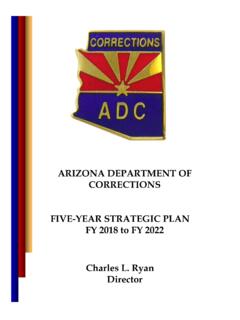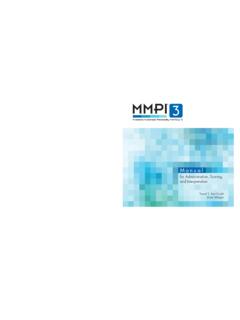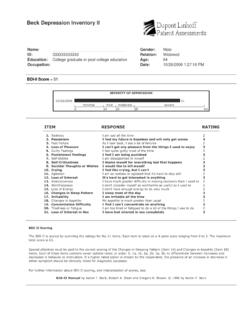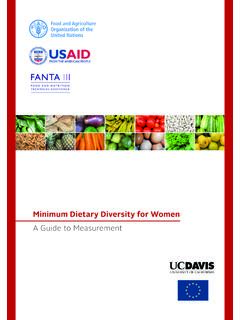Transcription of CHAPTER: 800 DEPARTMENT ORDER: Arizona Department
1 CHAPTER: 800 Inmate Management DEPARTMENT ORDER: 801 Inmate classification OFFICE OF PRIMARY RESPONSIBILITY: OPS Arizona DEPARTMENT of Corrections Rehabilitation and Reentry DEPARTMENT Order manual Effective Date: April 1, 2022 Amendment: June 10, 2022 Supersedes: DO 801 (7/21/17) Scheduled Review Date: July 1, 2024 ACCESS Contains Restricted Section(s) David Shinn, Director CHAPTER: 800 801 INMATE classification APRIL 1, 2022 TABLE OF CONTENTS EXPECTED PRACTICES .. 1 PURPOSE .. 1 PROCEDURES .. 1 classification SYSTEM OVERVIEW .. 1 CUSTODY LEVEL PURPOSE AND DESCRIPTIONS .. 2 INITIAL AND RECLASSIFICATION CUSTODY OBJECTIVE scoring CRITERIA .. 3 classification PROCESS .. 6 classification CUSTODY DISCRETIONARY OVERRIDES .. 8 INTERNAL RISK LEVEL PURPOSE AND DESCRIPTIONS .. 11 INITIAL AND RECLASSIFICATION INTERNAL RISK OBJECTIVE scoring CRITERIA.
2 11 classification - INTERNAL RISK DISCRETIONARY OVERRIDES .. 12 CRITERIA GOVERNING PLACEMENT INTO MAXIMUM CUSTODY .. 13 PROCEDURES FOR MAXIMUM CUSTODY PLACEMENT/REMOVAL THE HEARING PROCESS .. 14 classification CUSTODY APPEALS .. 16 ASSESSMENT SCORES.. 17 INTERSTATE CORRECTIONS COMPACT (ICC) INMATES.. 17 DO NOT HOUSE WITH VERIFICATION PROCESS VERIFICATIONS, REMOVALS/ADDITIONS .. 18 IMPLEMENTATION .. 19 DEFINITIONS/GLOSSARY .. 19 FORMS LIST .. 19 AUTHORITY .. 19 CHAPTER: 800 PAGE 1 801 INMATE classification APRIL 1, 2022 EXPECTED PRACTICES American Correctional Association (ACA) Expected Practices: 5-ACI-5B-01, 5-ACI-5B-02, 5-ACI-5B-04, 5-ACI-5B-05, and 5-ACI-5B-07 PURPOSE This DEPARTMENT Order outlines the inmate classification system and the process for the classifying of inmates according to their security risk.
3 This process considers behavior and other objective factors that are available and relevant when assessing an inmate s institutional custody and internal risk level. The classification system is a component of the inmate s Corrections Plan. PROCEDURES {5-ACI-5B-01} classification SYSTEM OVERVIEW The classification system consists of: Custody classification Determining the custody level based on the risk the inmate presents to the public and staff, as well as the time remaining until the inmate is released. Internal Risk Level Determining the internal risk level based on the risk the inmate presents to the public and staff and other inmates in order to assist in making decisions regarding housing and work assignments. Each inmate shall be individually assessed to ensure that the inmate s classification is appropriate for the assigned custody and internal risk level.
4 Inmates shall be initially classified at the Reception Centers. The Correctional Officer III (CO III) or Correctional Officer IV (CO IV) shall: {5-ACI-5B-05} Complete the initial classification and reclassification review assessments. Recommend the custody level, internal risk level, and institutional assignment. The Deputy Warden or designee shall review the CO III or CO IV recommendations and submit the final recommendation to Central Office classification . [Revision June 10, 2022] Inmates shall not reduce below the custody assigned at the initial classification for at least three months. Thereafter, an inmate s classification status shall be reviewed as events occur that will change the inmate's custody level (event driven), with the exception of overrides and Maximum Custody. See sections and for additional information on overrides and Maximum Custody time requirements.
5 Inmates with a non-discretionary override to Medium Custody based on a felony detainer or felony hold may reduce in custody prior to the three month time frame if the detainer or felony hold is cancelled and if the inmate scored in the Minimum Custody range at initial classification . Inmates with a discretionary override may be reviewed prior to the three month time frame if information is obtained that indicates the need for higher custody no longer exists. CHAPTER: 800 PAGE 2 801 INMATE classification APRIL 1, 2022 Inmates may appeal the classification decisions for the following: {5-ACI-5B-07} The rationale for placement as outlined in section Factual basis for scoring Custody level discretionary overrides Inmates shall be notified each time they are reclassified and their internal risk and/or custody score changes.
6 The inmate notification form shall be automatically generated each time an inmate is reclassified. For information regarding procedures on the inmate notification form see the classification Technical manual . Inmates returned to the DEPARTMENT with a new offense, who were on Community Supervision or in any Departmental release status at the time the new offense was committed, shall be classified at the receiving unit using the initial classification scoring criteria. Inmates returned to the DEPARTMENT as the result of technical violations of parole or a supervised release shall be classified at the receiving unit using the reclassification scoring criteria. Inmates who receive additional sentences while in DEPARTMENT custody shall be classified using the reclassification scoring criteria.
7 A classification appointment will only be set if the additional sentence(s) result in a higher custody than the inmate s current score. Inmates, whose sentence have been vacated and were re-sentenced without being released from the DEPARTMENT s custody, shall be classified using the reclassification criteria. The inmate is not required to return to Maximum Custody if reduction criteria had previously been met. CUSTODY LEVEL PURPOSE AND DESCRIPTIONS {5-ACI-5B-02} The custody level provides the minimum basis for classifying inmates to facilities. Inmates shall be placed at institutions that are consistent with the custody level necessary to ensure the safety and security of persons, the institution, and the community. An inmate may be housed temporarily or permanently in any facility which has capabilities exceeding the inmate s custody.
8 Each inmate shall be individually assessed to ensure an appropriate custody level assignment. Inmates are not permitted to request a particular custody level placement nor placement at a particular facility. There are insufficient resources available to transfer inmates for reasons of family hardships or any other elective reasons. Placement for these reasons shall not be recommended or approved. The inmate classification custody system consists of five custody levels based upon the inmate s likelihood of escape or committing violence: Maximum Custody Inmates who represent the highest risk to the public and staff and require housing in a single cell or double cell environment. These inmates have limited work opportunities within the secure perimeter and require frequent monitoring. These inmates require controlled movement within the institution.
9 This custody level does not apply to female inmates or juveniles adjudicated as adults. CHAPTER: 800 PAGE 3 801 INMATE classification APRIL 1, 2022 High Custody Inmates who represent a high risk to the public and staff. These inmates shall not be assigned to work outside the secure perimeter of an institution. These inmates require controlled movement within the institution. Medium Custody Inmates who represent a moderate risk to the public and staff. These inmates shall not work outside the secure perimeter of an institution and require limited controlled movement within the institution. Low Custody Inmates who represent a low risk to the public and staff. These inmates may work outside the secure perimeter of an institution, to include community work crews, and do not require controlled movement within the institution.
10 Minimum Custody Inmates who represent the lowest risk to the public and require minimal supervision. These inmates may be considered for community housing and work programs. INITIAL AND RECLASSIFICATION CUSTODY OBJECTIVE scoring CRITERIA {5-ACI-5B-07} The following risk criteria, along with the non-discretionary criteria outlined in of this section, shall be used for determining the custody levels for classification of inmates: Most serious current offense Most serious prior/other offense Escape history History of institutional violence Gang affiliation status Current age Completion of major programs (Reclassification only) Non-discretionary Overrides The following criteria requires the inmate to be classified no lower than the highest custody level associated with the criteria as applicable to the inmate. Death Sentence (All Adult Males) No less than High Custody Death Sentence (All Adult Females) - No less than High Custody Life Sentence 0-5 years served No less than High Custody Life Sentence more than 5 years served No less than Medium Custody Validated un-renounced Security Threat Group Who are placed in Maximum Custody per Security Threat Group (STG)/Special Services Unit (SSU) shall not reduce below Maximum Custody until completion of the required programming and have successfully completed a 24 month period, from the date of placement into Maximum Custody, where they have not participated in any documented STG/Gang or Terrorist activity.











